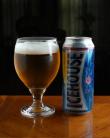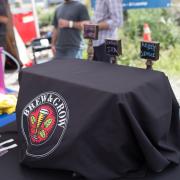What are the cheapest beers that people have made here? What are some good recipes that can be made for under $15.00 worth of ingredients from B&G or any supermarket?
Thu, Aug 7, 2014 - 2:02pm
#1
Cheapest Beer










About as cheap as I can go is my cream ale. It comes in at around 17 bucks for 5 gallons.
My other cheap recipe is my Aldi Cider. At around 1.69 a gallon and some .50 cent dry wine yeast, ya just can't get any cheaper...
That Aldi Cider sounds awesome - super efficient. Could I get that cream ale recipe from you? I want to try it out.
Here is a great source of recipes. Anything in catagory 6 (Light Hybrid) will be cheap to make. There is one titled $12 cream ale. The trick with cream asles is the fermentation temp wants to be closer to 60*. Blonde and american wheat have temps in line with our ferm room.
http://wiki.homebrewersassociation.org/BeerRecipes#6.
Group buys can get you a sack cheaper, but malteurope US 2-row is about $40 for I think a 60lb sack at brew and grow, that's less than a dollar a pound, buy hops by the pound, I use yakimavalleyhops.com, use US-05 yeast whih is about 2 bucks, add 5% crystal 40 per batch, That will get you about 5 batches of IPA at roughly $12 a batch. IPAs all day. Good ones too.
Buying sacks of base malt is definitely the way to go. 2 Home Depot buckets and omega lids or whatever they're called, will fit a 50 sack. Just buying base malts in bulk will save you tons of money.
Not buying bulk from B&G is a good place to start haha.
We spoke about corn and rice before, which is do-able, albiet most homebrewers here (I believe) will not have much experience using it. 50# sacks of flaked corn go for ~$20. Mix with 2 and 6 row to cut costs like BMC. I will warn you that there will be a steep learning curve with that as your beers will be buttery as hell with out right pitch rate, temps, etc.
1) How can I get in on a group buy of base malt and flaked corn?
2) Is there a point at which it becomes too late to run a diacetyl rest?
3) How do I go about conducting a mash of mostly rice? Do I also need malt with a high diastatic power, or can I get away with powdered amylase?
4) How does powdered amylase work? Are the alpha and beta mixed in equal parts under the assumption that the brewer will mash in at a temperature that favors one or the other? Or is the some other ratio of alpha to beta?
If you're going for the true cheapness route, you can do what the belgians have done by using sugar into the mash instead of grain. Sugar in bulk runs something like $.40 a pound and has a far higher yield than grains,
Theoretically, you can just directly add table sugar, but unless you're careful, you have the potential to blow out your yeast as the overabundance of sugar can stress the metabolic process.
In addition to creating sugar, the mashing process for grains creates amino acids, lipids, and nitrogen compouds which are vital to yeast metabolism in the fermenter. Too much sugar and not enough of the nutrient can do strange things to the fermentation.
In either case, this is going to be an issue you run into using rice adjuncts as well. Starters and yeast nutrient may become a staple for beers with adjuncts as a significant portion of the bill.
I would recommend pre-inverting the sugar by making a candi syrup. I'm just getting my feet wet with this process, but it allows you to put less-yeast-stressing food into the wort, and the process of making candi syrup can impart some great flavors and aromas to your beer at a low price! Also, since the process makes directly fermentable sugar, diastatic power won't be a limiting factor in your grain bill.
For nutrition, it may be worth is to start looking into some agricultural fertilizers for a bill with a high percentage of adjuncts. B&G sells diammonium phosphate, but ammonium nitrate is also a something you could use.
^^Bringing ammonium nitrate into the brewhouse seems like an unnecesary hazard with all the burners.^^
If I were making a really high gravity lager with rice and corn, wouldn't a starter have to be exceptionally huge for a five gallon batch? Would it be better to use the diammonium phosphate from B&G for nutritive purposes and pitch a ton of dry yeast?
How long does it take to make candi sugar? Does that add a substantial amount of time to the brew day?
1. Mark Walters is the group buy guy to talk to, your certainly welcome to get in on that.
2. Diacetyl rests are usually done at or toward the end of fermentation and really only apply to lagers. You can do a lot to avoid diacetyl by understanding it's precursor DMS, that chemical is present in certain grains more than others. By doing a 90 minute vigorous boil you can drive off somewhere around 85% of DMS, the yeast should be able to handle the rest if you give them enough time. I don't do diacetyl rests but I always do a 90 min. Boil, never had an issue.
3. All of the questions you have about mashing rice have been solved by the sake makers. There are home brewers making sake, I've never looked in to it myself, but it is being done.
4. I don't think you'd ever need to use powdered amylase. I encourage you to taste my 6-row malt school beer. 6-row has a bit of a rough flavor to it, so the rice and or corn smooths out it's edges nicely, 6-row also happens to have an obnoxiously high diastatic power so it performs very well with corn and rice.
As for the other questions, in my opinion you don't need ammonium hydroxide or whatever else...if you really want to add nutrients for your yeast Wyeast sells a vial of yeast nutrient, it's cheap and works great, or you can start looking at the water profile and making water additions. Lance from Omega Yeast is coming around again next Thursday I think, he can answer all your yeast nutrition questions.
As for your high gravity lager question, my dopplebock I just brewed was 1.100 which will end up around 9-10% and the pitch rate calculator said I needed 4 packets of dry yeast. If I used a starter it would have been 5 or 6 liters. That's why I use dry yeast. Also I did not use any yeast nutrients, besides my water additions if you count those,in that beer and thus far it tastes great and the yeast are chugging right along.
If brewing with adjuncts is something you're interested in I'm in the early stages of planning a pre-prohibition American Lager. A rich, malty, and flavorful style that uses corn. It's my intention to brew this pretty soon so we can serve it at our harvest fest in the fall, I'd be willing to collaborate on it with you. Thus far I'm thinking 6-row, Vienna, and corn, or something like that, I have more research to do on it.
I would like to clarify joes comments on how diacetyl is formed. It has nothing to do with DMS and a rolling 90 boil will not mitigate it. Joe is correct however that DMS, another chemical compound that causes an off flavor that can be per roved as cooked corn or at high levels as rotting cabbage, will be driven off by a 90 min boil.
Diacetyl is caused and cleaned up in the fermentation process. Most of the compound is formed within the fist few days of fermentation and is subsequently broken down by the yeast once all the sugars have been metabolized. For more information see this link.
http://www.professorbeer.com/articles/diacetyl.html